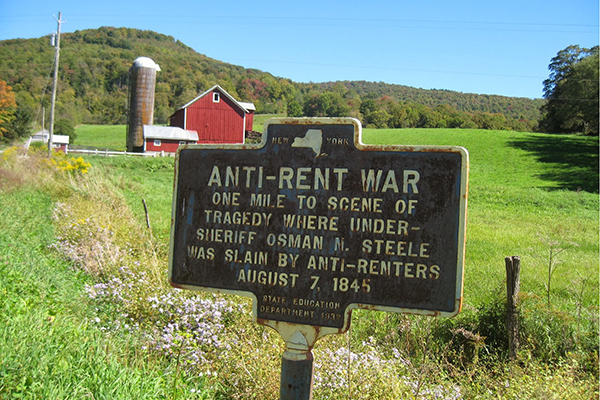The Anti-Rent War was centered in the Catskills and pitted farmers against the landowning elite, known as the UpRenters. The Anti-Renters believed they had been misled into entering leases that were unjust. The UpRenters believed a contract was a contract.
The Anti-Rent War (also known as the Helderberg War) was centered in the Catskills between 1839 and 1845. It is often seen as an extension of the American Revolution in that it further separated the new American democracy from older European political and socio-economic systems. After the Revolution ended, some powerful Federalist families (Van Rensselaer, Livingston, Schuyler, and Hamilton for example) were rewarded for their duty by being given large tracts of land in the Hudson River Valley and the Catskills. There were anti-feudal laws in place, but these large landowners found ways to circumvent these laws. They lured settlers to their lands by letting them homestead there for free for 7 years. Some believe they also misled the renters with promises of fertile farmland. After this time was up, they would have to pay a wheat rent, in addition to other terms of service. The problem was that much of this land was on rocky, unproductive forest. After developing this land for 7 years with backbreaking labor, they found that they had much difficulty producing enough crops to pay off the required rent and provide for their families. They were also responsible for the taxes on the property.
While Stephen Van Rensselaer III was alive he was fairly lenient with his tenants, allowing them to make partial payments. Upon his death in 1839, his children were given his massive debt. Their solution to paying this off was to collect the back-rent owed by his tenants. When the tenants were unable or unwilling to pay, law enforcement was often sent in to collect their livestock to sell off in the place of rent payment. Many of the tenant farmers banded together to consolidate their strength while protesting. In order to protect their identities they dressed up as “Calico Indians.” I have read that this was their interpretation of what the Boston Tea Partiers looked like, (although they were pretty far off the mark). I’ve also seen that the brightly colored calico prints had their origin in India. Either way, they would wear some variation of sheepskin masks, deer antlers, tails, and colorful dresses. They armed themselves with whatever they had around the farm; knives, muskets, pistols, spears, hatchets, scythes, etc. They formed cells of 10-15 men and would communicate across large distances by blowing tin horns that were ordinarily used to call workers in from the fields for dinner.

Calico Indians' disguises.
While the conflicts with law enforcement were certainly very threatening, they rarely turned violent. That was until August 1845 when Sherriff Green More and his undersheriff Osman Steele rode to the farm of Moses Earle on Dingle Hill south of Andes, NY to sell off some of his livestock to pay his back rent. A group of Calico Indians surrounded them. Shots were fired and Steele was hit three times. He was taken to either Hunting Tavern in Andes or the Erle farm and died later that day. Ironically, earlier that day he supposedly bragged while in Hunting Tavern that “Lead cannot penetrate Steele.” That quote can be seen on a sign east of Andes today. Who knows if he actually said it.
Prior to this event, the Anti-Rent War was certainly very serious, but it also had a somewhat playful tone. Many of the Calico Indians were thought to be little more than teenage boys who thought the experience would be fun. Steele’s death prompted the cells to disband. Mass arrests of suspected “Indians” followed. However, the event caused more serious political action to be taken. In 1846, a pro Anti-Renter, John Young, was elected governor of New York and pardoned the convicted “Indians.” Shortly afterwards the legislature abolished the tenure rent system. The Anti-Renters had won.

There is a fairly large amount of work available on the Anti-Rent War if you would like a lot more information than I provided. For this blog, I extensively used Thom Metzger’s article “Transform and Rebel: The Calico Indians and the Anti-rent War” and Nancy S. Canon’s article “Reform/Conflict: The Anti-Rent Movement: Brief Introduction”. There are also several books available which I may (eventually) get around to reading. A big part of the reason why I love living in the Northeast is the seemingly endless amount of early American history that occurred here.





